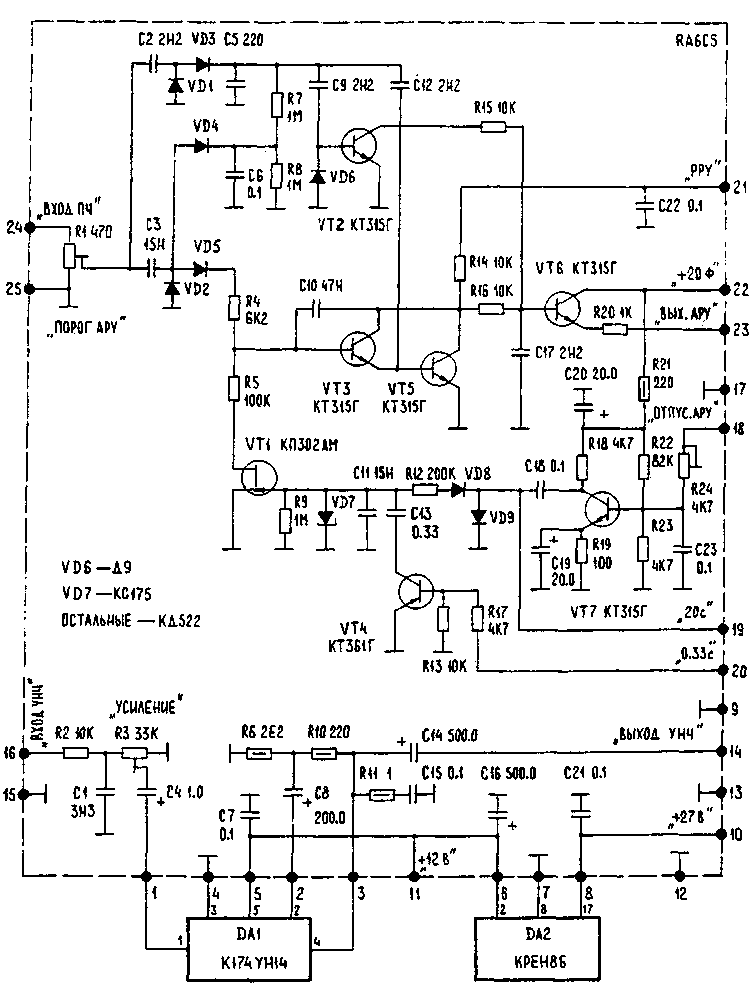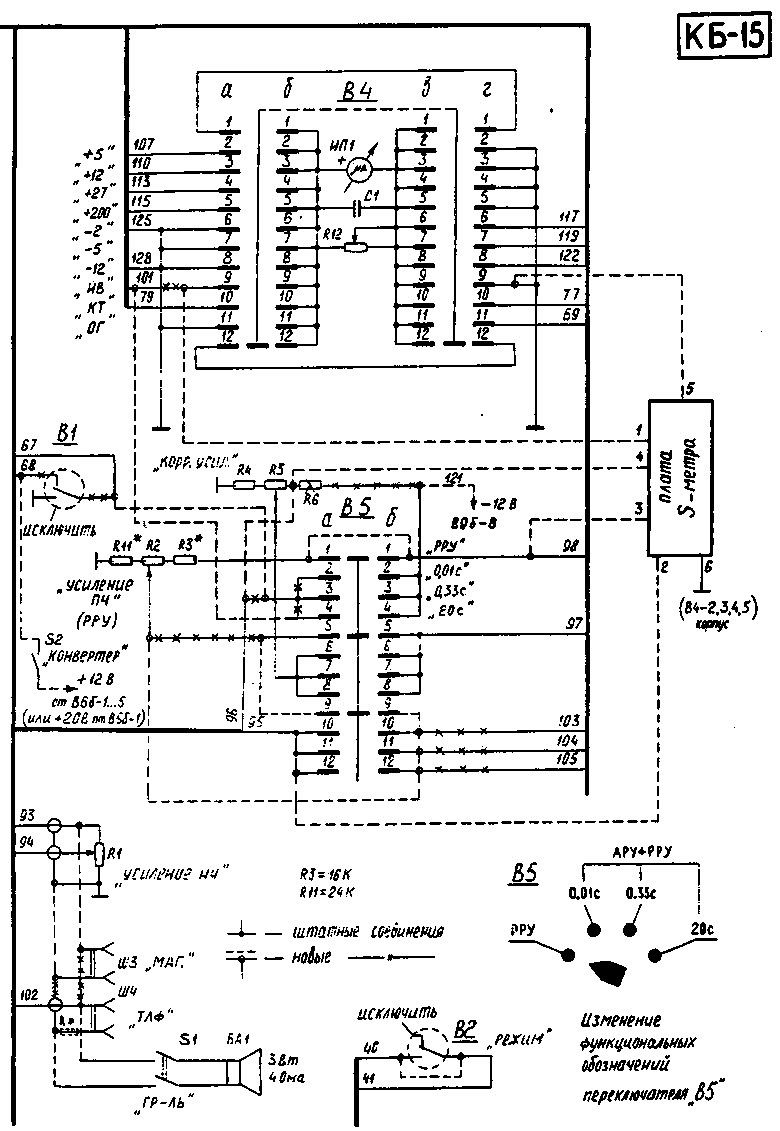
|
|
ENCYCLOPEDIA OF RADIO ELECTRONICS AND ELECTRICAL ENGINEERING Modernization of radio receiver units Katran. Encyclopedia of radio electronics and electrical engineering
Encyclopedia of radio electronics and electrical engineering / radio reception In this receiver, as in many other "army" devices, in my opinion, not enough attention is paid to the development of AGC and ULF units. As a result, the quality of work of these units leaves much to be desired. With an AGC time constant of 0,05 s, the air “squeals like bacon in a frying pan”, and at 1 s, the leading edge of the signal beats on the ears.” Only with an AGC time constant of 0,1 s, more or less normal reception is provided, but the output transistors in the low-frequency amplifier work without a quiescent current, so there can be no talk of any signal quality. - the amplifier is not suitable for them. I propose to dismantle the ULF board (K1211) and install a new AGC and ULF board in its place. The circuit board is shown in Fig.1. The bass amplifier is made on the IC OA1 (K174UN14) according to a typical scheme. Resistor R3 sets the maximum volume level at the appropriate position of the "LF Gain" knob. The KREN8B stabilizer is used to power the ULF. The voltage at terminal 11 of the "+12V" board can be used for subsequent upgrades in the unit. When developing the AGC, the principle laid down in the circuit of the "YES-93" transceiver was used, as the most progressive, in my opinion, of all previously published in amateur radio literature. The IF signal (215 kHz) is fed to the R1 "ARC Threshold" knob. From the regulator engine, a useful signal is fed to the input of the integrator (VT3, VT5). The use of an integrator allows the use of a small capacitor C10 and a very high AGC response speed. At the first period of the IF signal, the voltage on the collectors VT3, VT5 decreases, causing a decrease in the AGC output voltage at pin 23 of the board. The gain of the IF path jumps down. If the signal does not contain a low-frequency component, the AGC time constant is determined by resistor R5, the lower output of which is connected to the case through an open transistor VT1. In this case, short-term signals are quickly processed by the AGC circuit. If there is a low-frequency component in the signal with a sufficient level (adjusted using R24), this component is amplified by the transistor VT7, detected by the diodes VD8, VD9, and the resulting negative voltage turns off the transistor VT1. In this case, the AGC time constant is determined by the capacitance C10 and is about 10 s. When receiving a speech signal, the AGC voltage remains constant in value in the pauses between individual sounds, which significantly improves the reception quality. When the low-frequency signal disappears, the transistor VT1 opens after a while, and the sensitivity of the receiver is quickly restored. The AGC "release" delay time depends on the capacitance of capacitors C11 and C13. In the position of the AGC response time switch "0,01 s", only the capacitor SP works. In the "0,33 s" transistor VT4 unlocks and connects the capacitor C13. In the "20 s" position, the transistor VT1 is locked by the negative voltage supplied through terminal 19. A pulse detector is made on diodes VD1, VD3, VD4. Rectified short pulses of positive polarity unlock the transistor VT2, which briefly shunts the base circuit of the emitter follower VT6, causing a decrease in the AGC voltage. Thus, some types of impulse noise are "worked out" without triggering the integrator. The manual gain control voltage is supplied from the KB15 block to terminal 21 of the board. When working with AGC, the "IF Gain" regulator can smoothly set the upper limit of the receiver's sensitivity. Figures 2 and 3 show a drawing of a printed circuit board and the location of parts on it of the AGC and ULF assembly.
The S-meter board allows you to use a standard monitoring device to measure the strength of signals within 4 ... 9 +60 dB. The scheme and drawings of the printed circuit board are shown in Fig.4...6. The board has two holes for the nuts of the measuring device for its fastening. Figure 7 shows a diagram of changes in the output circuits of the IF (K1208). The refinement consists mainly in reducing the excess gain of the path, which causes an overload of the detectors and causes increased receiver noise. The "native" (factory) AGC scheme must be disabled or completely dismantled. Figure 8 shows the changes that need to be made in the control and monitoring unit KB15 (front panel). When installing the AGC and ULF board in the KB12 block, you need to unsolder the wire "1" from the Sh7 / B1 contact and solder the wire from the 20th output of the board instead. For loud-speaking reception, a speaker can be installed in the KB15 unit. To do this, the noise level control is moved to another place, and the speaker is installed to the left of the keyboard. A hole is sawn into the panel, which is closed from the outside with a decorative black grille.
To improve the control characteristics of the AGC, it is desirable to "tinker" with the K1207 board. First, you need to reduce the capacitance of the capacitors in the gain control circuits: C9, C17 - 33000 pF; C12, C21 - 1200 pF. Ratings of resistors R9, R18 -1 kOhm. Secondly, it is desirable to carefully select the values of the resistors R17 or R25 in such a way that when the signal increases, the transistor T6 first “works out”, and then the TK. At the same time, there should not be a “gap” between their “work”, i.e. there must be a continuous control curve. In this case, a sufficiently linear adjustment is provided. Author: S.Popov (RA6CS), Krasnodar Territory, village of Afipsky; Publication: N. Bolshakov, rf.atnn.ru
Artificial leather for touch emulation
15.04.2024 Petgugu Global cat litter
15.04.2024 The attractiveness of caring men
14.04.2024
▪ Portable mobile phone printer ▪ The most powerful gantry crane ▪ Flex ATX 500 W 80 Plus Platinum Power Supply ▪ MediaTek MT6589 single-chip system ▪ The first polymer solar power plant
▪ section of the site Standard instructions for labor protection (TOI). Selection of articles ▪ Article Protection of reservoirs. Consequences of pollution. Basics of safe life ▪ mushroom article. Travel Tips ▪ article Correspondence of models of TV, video, audio equipment and BQS remote controls. Directory
Home page | Library | Articles | Website map | Site Reviews www.diagram.com.ua |






 Arabic
Arabic Bengali
Bengali Chinese
Chinese English
English French
French German
German Hebrew
Hebrew Hindi
Hindi Italian
Italian Japanese
Japanese Korean
Korean Malay
Malay Polish
Polish Portuguese
Portuguese Spanish
Spanish Turkish
Turkish Ukrainian
Ukrainian Vietnamese
Vietnamese








 Leave your comment on this article:
Leave your comment on this article: